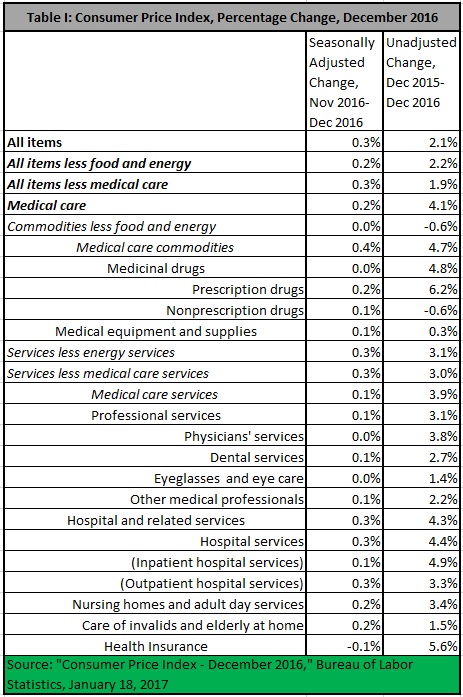CPI: Moderate Health Price Increases
 The Consumer Price Index rose 0.3 percent in December. Medical prices rose only 0.2 percent. This is the fourth month in a row we have enjoyed medical price relief. Even prices of prescription drugs rose by only 0.2 percent. Prices of health insurance even dropped a smidgeon!
The Consumer Price Index rose 0.3 percent in December. Medical prices rose only 0.2 percent. This is the fourth month in a row we have enjoyed medical price relief. Even prices of prescription drugs rose by only 0.2 percent. Prices of health insurance even dropped a smidgeon!
Prices for medical care commodities rose the most, by 0.6 percent, followed closely hospital services (0.3) percent).
Over the last 12 months, however, medical prices have increased over twice as fast as non-medical prices: 1.9 percent versus 4.1 percent. Price changes for medical care contributed 16 percent of the overall increase in CPI.
Many observers of medical prices decline to differentiate between nominal and real inflation. Because CPI is has been low until recently, even relatively moderate nominal price hikes for medical care are actually substantial real price hikes. More than six years after the Affordable Care Act was passed, consumers have not seen relief from high medical prices, which have increased over twice as much as the CPI less medical care since March 2010, the month President Obama signed the law.
(See Figure I and Table I below the fold.)
Technical Note: Professor Christopher Conover explains why some scholars de-emphasize CPI and medical CPI as appropriate measures of inflation for health care, preferring another dataset, Personal Consumption Expenditures (PCE). There are very good reasons for such a conclusion. However, CPI comes out monthly. The PCE price index is updated only quarterly, and that is only for services. Prices for goods, such as drugs and medical devices, are updated only annually. Plus, consumers only really care about price increases they experience directly, not price increases borne by other economic actors.




And, our nation’s maternal mortality ratio in the last 3 years has suddenly worsened, on top of its long-term worsening for 30 years. Among the world’s developed nation’s, we rank within the 5 worst of these nations. It is probably the most accurate over-all measure of the equitable availability and ecologically accessible character of our nation’s healthcare. The portion of our national economy devoted to this healthcare will not improve without a reform commitment to resolve its availability and accessibility problems. At least 400 women die annually with a pregnancy in the USA just because they live in the wrong nation. The loss of ‘social capital’ for their families is profound. A multiplier effect then occurs for their community.
“we rank within the 5 worst of these nations. It is probably the most accurate over-all measure of the equitable availability and ecologically accessible character of our nation’s healthcare”
Without questioning your ranking or how the various countries define and report maternal mortality don’t you think that socio economic factors weigh heavily on these numbers especially since so many maternal deaths are linked to drug and alcohol use?
I am not sure how maternal death is calculated. I think WHO uses 6 weeks and some reporting in the US I believe is 1 year, but I don’t know how WHO gathers its statistics if that is the number you are quoting.
I wonder where you got the number and if from a secondary or tertiary source where they got it from.
You mean giving people subsidized health insurance and subsidized out of pocket costs didn’t control the over utilization of escalating health care? That just doesn’t seem possible . 😱
It has worked so well with university tuition, too!